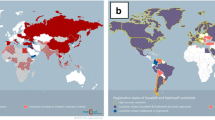Abstract
Chronic hepatitis B infection is a very important health problem in China, which is carrying an enormous economic and social burdens. The major routs of chronic hepatitis B infection in China are mother-infant vertical transmission and early childhood horizontal transmission. After more than 10 years implementation of universal vaccination against hepatitis B in newborns and safety injection in health care settings, the prevalence of HBsAg in general population has decreased from 9.75% to around 7%. In China, patients with hepatitis are cared by either hepatologists or physicians of infectious diseases. The Chinese Society of Hepatology, and Chinese Society of Infectious Diseases jointly issued an evidence-based guideline on the prevention and treatment of chronic hepatitis B in 2005. This guideline concisely describes the virology, epidemiology, natural history and prevention, as well as diagnosis and management of chronic hepatitis B. It also highlights the importance of active viral replication in disease progression in chronic HBV infection and explicitly states the necessity of antiviral therapy in patient care. The cornerstone of anti-hepatitis B therapy is optimal use of interferons or nucleos(t)ide analogs in those patients with active viral replication and elevated serum transaminase levels. Through an independent continue medical educational agency, a panel of selected speakers were trained to give well-formatted talks on the key points of the guideline in over 60 major cities across China. This educational campaign among health care providers has greatly improved the awareness and the stand of care for antiviral therapy.
Similar content being viewed by others
References
Chen C J, Yang H I, Su J, et al. 2006. Risk of hepatocellular carcinoma across a biological gradient of serum hepatitis B virus DNA level. JAMA, 295(1): 65–73.
Chinese Society of Hepatology and Chinese Society of Infectious Diseases. 2005. Guideline on the prevention and treatment of chronic hepatitis B. Chin J Hepatol, 13: 881–891.
Chinese Society of Hepatology and Chinese Society of Infectious Diseases. 2007. Guideline on the prevention and treatment of chronic hepatitis B. Chin Med J (Engl), 120(24): 2159–2173.
Dai Z C, Qi G M. 1997. Viral hepatitis in China: Seroepidemiological survey in Chinese population (Part one). Beijing: Beijing Science and Technology Press. p39–58.
Giovanna F, Bortolotti F, Francesco D. 2008. Natural history of chronic hepatitis B: Special emphasis on disease progression and prognostic factors. J Hepatol, 48(2): 335–352.
Hou J L, Yin Y K, Xu D Z, et al. 2008. Telbivudine versus Lamivudine in Chinese Patients with Chronic Hepatitis B: Results at 1 Year of a Randomized, Double-Blind Trial. Hepatology, in press.
Iloeje U H, Yang H I, Su J, et al. 2006. Predicting Cirrhosis Risk Based on the Level of Circulating Hepatitis B Viral Load. Gastroenterology, 130: 678–686.
Liang X F, Chen Y S, Wang X J, et al. 2005. A study on the sero-epidemiology of hepatitis B in Chinese population aged over 3-years old. Chin J Epidemiol, 26: 655–658.
Lau G K, Piratvisuth T, Luo K X, et al. 2005. Peginterferon Alfa-2a, lamivudine, and the combination for HBeAg-positive chronic hepatitis B. N Engl J Med, 352: 2682–2695.
Ministry of Public Health. 2007. Chinese Health Statistical Digest. http://www.moh.gov.cn/newshtml/19165.htm
Sørensen H T, Lash T L, Rothman K J. 2006. Beyond randomized controlled trials: a critical comparison of trials with nonrandomized studies. Hepatology. 44(5): 1075–1082.
World Health Organization. 2000. Hepatitis B. World Health Organization Fact Sheet 204 dex. (Revised October). WHO Web site. http://www.who.int/mediacentre/factsheets/fs204/en.htm
Yao G, Wang B, Cui Z, et al. 1999. A randomized double-blind placebo-controlled study of lamivudine in the treatment of patients with chronic hepatitis B virus infection. Chin Med J (Engl). 112: 387–391.
Zeng M, Mao Y, Yao G, et al. 2006. A double-blind randomized trial of adefovir dipivoxil in Chinese subjects with HBeAg-positive chronic hepatitis B. Hepatology, 44: 108–116.
Zhu X, Zhang X L, Wang L X. 2000. National EPI vaccination and hepatitis B coverage rate and the related factors: resuls from the 1999 national coverage survey. Chin J Vac Immun, 6: 1–5.
Author information
Authors and Affiliations
Corresponding author
Additional information
Foundation items: This paper is partly supported by National 863 grant (2006AA02A40)
Rights and permissions
About this article
Cite this article
Jia, Jd. Hepatitis B in China: from guideline to practice. Virol. Sin. 23, 152–155 (2008). https://doi.org/10.1007/s12250-008-2953-8
Received:
Accepted:
Published:
Issue Date:
DOI: https://doi.org/10.1007/s12250-008-2953-8



